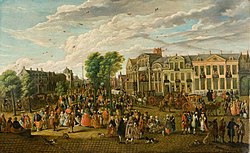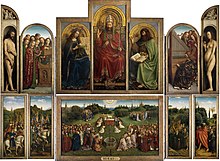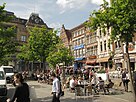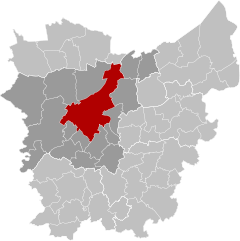
A | B | C | D | E | F | G | H | CH | I | J | K | L | M | N | O | P | Q | R | S | T | U | V | W | X | Y | Z | 0 | 1 | 2 | 3 | 4 | 5 | 6 | 7 | 8 | 9
Ghent
Gent (Dutch) Gand (French) | |
|---|---|
City and municipality | |
Clockwise from top: the Graslei, the Gravensteen, Ghent Tower Row (St. Nicholas' Church, Belfry, St. Bavo's Cathedral), and the Vrijdagmarkt | |
| Coordinates: 51°03′13″N 03°43′31″E / 51.05361°N 3.72528°E | |
| Country | |
| Community | Flemish Community |
| Region | Flemish Region |
| Province | East Flanders |
| Arrondissement | Ghent |
| Government | |
| • Mayor (list) | Mathias De Clercq (Open VLD) |
| • Governing party/ies | Vooruit-Groen, Open VLD, CD&V |
| Area | |
| • Total | 157.77 km2 (60.92 sq mi) |
| Population (2022-01-01)[1] | |
| • Total | 265,086 |
| • Density | 1,700/km2 (4,400/sq mi) |
| Postal codes | 9000–9052 |
| NIS code | 44021 |
| Area codes | 09 |
| Website | www.gent.be |
 Logo of Ghent | |
Ghent (Dutch: Gent [ɣɛnt] ⓘ; French: Gand [ɡɑ̃] ⓘ; historically known as Gaunt in English) is a city and a municipality in the Flemish Region of Belgium. It is the capital and largest city of the East Flanders province, and the third largest in the country, after Brussels and Antwerp.[2] It is a port and university city.
The city originally started as a settlement at the confluence of the Rivers Scheldt and Leie and in the Late Middle Ages became one of the largest and richest cities of northern Europe, with some 50,000 people in 1300. After the late 16th century Ghent became a less important city, resulting in an extremely well-preserved historic centre, that now makes Ghent an important destination of tourism.
The municipality comprises the city of Ghent proper and the surrounding suburbs of Afsnee, Desteldonk, Drongen, Gentbrugge, Ledeberg, Mariakerke, Mendonk, Oostakker, Sint-Amandsberg, Sint-Denijs-Westrem, Sint-Kruis-Winkel, Wondelgem and Zwijnaarde. With 262,219 inhabitants at the beginning of 2019, Ghent is Belgium's second largest municipality by number of inhabitants. The metropolitan area, including the outer commuter zone, covers an area of 1,205 km2 (465 sq mi) and had a total population of 560,522 as of 1 January 2018, which ranks it as the fourth most populous in Belgium.[3][4] The current mayor of Ghent is Mathias De Clercq (Open Vld).
The ten-day-long Ghent Festival (Gentse Feesten) is held every year and attended by about 1–1.5 million visitors.
History
This section needs additional citations for verification. (May 2013) |
Archaeological evidence shows human presence around the confluence of the Scheldt and the Leie going back as far as the Stone Age and the Iron Age.[5]
Most historians believe that the older name for Ghent, 'Ganda', is derived from the Celtic word ganda, which means ‘confluence’,[5] or ‘river mouth’, referring to the Leie river debouching into the Scheldt. Other sources connect its name with an obscure deity named Gontia.[6]
There are no written records of the Roman period, but archaeological research confirms that the Gent area continued to be inhabited.
When the Franks invaded the Roman territories from the end of the 4th century and well into the 5th century, they brought their language with them, and Celtic and Latin were replaced by Old Dutch.
Middle Ages

Around 650, Saint Amand founded two abbeys in Ghent: St. Peter's (Blandinium) and St. Bavo's Abbey. Around 800, Louis the Pious, son of Charlemagne, appointed Einhard, the biographer of Charlemagne, abbot of both abbeys. The city grew from several nuclei, the abbeys, and a commercial centre. However, in 851 and 879 the city was plundered by Vikings.
Under the protection of the County of Flanders the city recovered and flourished from the 11th century, growing to become a small city-state. By the 13th century, Ghent was the biggest city in Europe north of the Alps after Paris; it was bigger than Cologne or Moscow.[7] Up to 65,000 people lived within the city walls. The belfry and the towers of the St. Bavo's Cathedral and St. Nicholas' Church are just a few examples of the skyline of the period.
The rivers flowed in an area where much land was periodically flooded. These rich grass 'meersen' ("water-meadows": a word related to the English 'marsh') were ideally suited for herding sheep, the wool of which was used to make cloth. Ghent was the leading city for cloth during the Middle Ages.
The wool industry, originally established at Bruges, created the first European industrialized zone in Ghent in the High Middle Ages. The mercantile zone was so highly developed that wool had to be imported from Scotland and England, which led to Flanders' good relationship with them. However, during the Hundred Years' War, trade with England suffered significantly. Ghent was the birthplace of John of Gaunt, Duke of Lancaster.
Early modern period
The city recovered in the 15th century when Flanders was united with neighbouring provinces under the Dukes of Burgundy. High taxes led to a rebellion and eventually to the Battle of Gavere in 1453, in which Ghent suffered a terrible defeat at the hands of Philip the Good. Around this time the centre of political and social importance in the Low Countries started to shift from Flanders (Bruges–Ghent) to Brabant (Antwerp–Brussels), although Ghent continued to play an important role. With Bruges, the city led two revolts against Maximilian of Austria, the first monarch of the House of Habsburg to rule Flanders.


In 1500, Juana of Castile gave birth to Charles V, who became Holy Roman Emperor and King of Spain. Although native to Ghent, he punished the city after the 1539 Revolt of Ghent and obliged the city's nobles to walk in front of the Emperor barefoot with a noose (Dutch: "strop") around the neck; since this incident, the people of Ghent have been called "Stroppendragers" (noose bearers). St. Bavo's Abbey (not to be confused with the nearby St. Bavo's Cathedral) was abolished, torn down, and replaced with a fortress for Royal Spanish troops. Only a small portion of the abbey was spared demolition.


The late 16th and 17th centuries brought devastation because of the Eighty Years' War. The war ended the role of Ghent as a centre of international importance. In 1745, the city was captured by French forces during the War of the Austrian Succession before being returned to the Empire of Austria under the House of Habsburg following the Treaty of Aix-la-Chapelle in 1748. This part of Flanders became known as the Austrian Netherlands until the exile of the French Emperor Napoleon I, the end of the French Revolutionary and later Napoleonic Wars, and the peace treaties arrived at by the Congress of Vienna in 1815.
19th century

In the 18th and 19th centuries, Ghent's textile industry flourished again. Lieven Bauwens, having smuggled the industrial and factory machine plans out of England, introduced the first mechanical weaving machine on the European continent in 1800.
The Treaty of Ghent, negotiated here and adopted on Christmas Eve 1814, formally ended the War of 1812 between Great Britain and the United States (the North American phase of the Napoleonic Wars). After the Battle of Waterloo, Ghent and Flanders, previously ruled from the House of Habsburg in Vienna as the Austrian Netherlands, became a part of the United Kingdom of the Netherlands with the northern Dutch for 15 years. In this period, Ghent established its own university (1816)[8] and a new connection to the sea (1824–27).
After the Belgian Revolution, with the loss of port access to the sea for more than a decade, the local economy collapsed, and the first Belgian trade union originated in Ghent. In 1913 there was a world exhibition in Ghent.[8] As a preparation for these festivities, the Sint-Pieters railway station was completed in 1912.
20th century
Ghent was occupied by the Germans in both World Wars but escaped severe destruction. The life of the people and the German invaders in Ghent during World War I is described by H. Wandt in "etappenleven te Gent".[9] In World War II the city was liberated by the British 7th "Desert Rats" Armoured Division and local Belgian fighters on 6 September 1944, with the northern suburbs and the industrial area cleared over the following days by the 15th (Scottish) Infantry Division.
Geography

After the fusions of municipalities in 1965 and 1977, the city is made up of following sub-municipalities:
- I Ghent
- II Mariakerke
- III Drongen
- IV Wondelgem
- V Sint-Amandsberg
- VI Oostakker
- VII Desteldonk
- VIII Mendonk
- IX Sint-Kruis-Winkel
- X Ledeberg
- XI Gentbrugge
- XII Afsnee
- XIII Sint-Denijs-Westrem
- XIV Zwijnaarde
Neighbouring municipalities
Climate
The climate in this area has mild differences between highs and lows, and there is adequate rainfall year-round. According to the Köppen climate classification system, Ghent has a marine west coast climate, abbreviated "Cfb" on climate maps.[10]
| Climate data for Ghent (1981–2010 normals, sunshine 1984–2013) | |||||||||||||
|---|---|---|---|---|---|---|---|---|---|---|---|---|---|
| Month | Jan | Feb | Mar | Apr | May | Jun | Jul | Aug | Sep | Oct | Nov | Dec | Year |
| Mean daily maximum °C (°F) | 6.2 (43.2) |
7.0 (44.6) |
10.8 (51.4) |
14.5 (58.1) |
18.1 (64.6) |
20.6 (69.1) |
23.0 (73.4) |
22.9 (73.2) |
19.7 (67.5) |
15.3 (59.5) |
10.1 (50.2) |
6.5 (43.7) |
14.7 (58.5) |
| Daily mean °C (°F) | 3.4 (38.1) |
3.8 (38.8) |
6.8 (44.2) |
9.4 (48.9) |
13.2 (55.8) |
15.9 (60.6) |
18.1 (64.6) |
17.9 (64.2) |
14.9 (58.8) |
11.2 (52.2) |
7.0 (44.6) |
4.0 (39.2) |
10.6 (51.1) |
| Mean daily minimum °C (°F) | 0.7 (33.3) |
0.4 (32.7) |
2.7 (36.9) |
4.5 (40.1) |
8.3 (46.9) |
11.1 (52.0) |
13.2 (55.8) |
12.8 (55.0) |
10.2 (50.4) |
7.2 (45.0) |
3.9 (39.0) |
1.5 (34.7) |
6.4 (43.5) |
| Average precipitation mm (inches) | 70.7 (2.78) |
56.2 (2.21) |
61.5 (2.42) |
50.6 (1.99) |
63.1 (2.48) |
74.3 (2.93) |
77.4 (3.05) |
84.2 (3.31) |
74.2 (2.92) |
81.7 (3.22) |
82.7 (3.26) |
82.2 (3.24) |
858.8 (33.81) |
| Average precipitation days | 12.6 | 10.8 | 12.0 | 10.1 | 11.1 | 10.5 | 10.3 | 10.0 | 10.9 | 12.1 | 13.4 | 13.0 | 136.8 |
| Mean monthly sunshine hours | 61 | 79 | 123 | 172 | 204 | 196 | 209 | 196 | 144 | 118 | 66 | 50 | 1,618 |
| Source: Royal Meteorological Institute[11] | |||||||||||||
Demographics
Nationalities
Ghent is home to many people of foreign origin and immigrants. The 2020 census[12] revealed that 35.5% of the inhabitants had roots outside of Belgium and 15.3% had a non-Belgian nationality. Many neighbourhoods already have a minority-majority population, primarily in the north, east, and west of the city and some pockets in the south. Some examples are Brugse Poort, Dampoort, Rabot, Ledeberg, Nieuw Gent/UZ and the area around Sleepstraat (known for its many Turkish restaurants).
| Group of origin | Year | |
|---|---|---|
| 2023[13] | ||
| Number | % | |
| Belgians with Belgian background | 165,164 | 61.6% |
| Belgians with foreign background | 56,990 | 21.26% |
| Neighboring country | 5,523 | 2.06% |
| EU27 (excluding neighboring country) | 5,354 | 2% |
| Outside EU 27 | 46,113 | 17.2% |
| Non-Belgians | 45,968 | 17.14% |
| Neighboring country | 4,691 | 1.75% |
| EU27 (excluding neighboring country) | 20,355 | 7.59% |
| Outside EU 27 | 20,922 | 7.8% |
| Total | 268,122 | 100% |
Culture and tourism
Architecture






Much of the city's medieval architecture remains intact and is remarkably well preserved and restored. Its centre is a carfree area. Highlights are St. Bavo's Cathedral with the Ghent Altarpiece, the belfry, the Gravensteen castle, and the splendid architecture along the old Graslei harbour. Ghent has established a blend between comfort of living and history; it is not a city-museum. The city of Ghent also houses three béguinages and numerous churches including St. Jacob's Church, St. Nicholas' Church, St. Michael's Church and St. Stefanus' Church.

In the 19th century Ghent's most famous architect, Louis Roelandt, built the university hall Aula, the opera house, and the main courthouse. Highlights of modern architecture are the university buildings (the Boekentoren or Book Tower) by Henry Van de Velde. There are also a few theatres from diverse periods.
The beguinages, as well as the belfry and adjacent cloth hall, were recognized by UNESCO as World Heritage Sites in 1998 and 1999.
The Zebrastraat, a social experiment in which an entirely renovated site unites living, economy, and culture, can also be found in Ghent.
Campo Santo is a famous Catholic burial site of the nobility and artists.
One of the more notable pieces of contemporary architecture in Ghent is De Krook, the new central library and media center, a collaboration between local firm Coussée and Goris and Catalan firm RCR Arquitectos.
Museums
Important museums in Ghent are the Museum voor Schone Kunsten (Museum of Fine Arts), with paintings by Hieronymus Bosch, Peter Paul Rubens, and many Flemish masters; the SMAK or Stedelijk Museum voor Actuele Kunst (City Museum for Contemporary Art), with works of the 20th century, including Joseph Beuys and Andy Warhol; and the Design Museum Gent with masterpieces of Victor Horta and Le Corbusier. The Huis van Alijn (House of the Alijn family) was originally a beguinage and is now a museum for folk art where theatre and puppet shows for children are presented. The Museum voor Industriële Archeologie en Textiel or MIAT displays the industrial strength of Ghent with recreations of workshops and stores from the 1800s and original spinning and weaving machines that remain from the time when the building was a weaving mill. The Ghent City Museum (Stadsmuseum, abbreviated STAM), is committed to recording and explaining the city's past and its inhabitants, and to preserving the present for future generations.
Theatre
NTGent is the city theatre of Ghent, a public institution known for its radical productions. The theatre company's home base is in the Royal Dutch Theatre (Koninklijke Nederlandse Schouwburg, or KNS), with a secondary location in the city at Minnemeers. The company also tours extensively.[14]
Restaurants and culinary traditions
In Ghent and other regions of East Flanders, bakeries sell a donut-shaped bun called a "mastel" (plural "mastellen"), which is basically a bagel. "Mastellen" are also called "Saint Hubert bread", because, on the Saint's feast day, which is 3 November, the bakers bring their batches to the early Mass to be blessed. Traditionally, it was thought that blessed mastellen immunized against rabies.
Other local delicacies are the praline chocolates from local producers such as Leonidas, the cuberdons or 'neuzekes' ('noses'), cone-shaped purple jelly-filled candies, 'babelutten' ('babblers'), hard butterscotch-like candy, and of course, on the more fiery side, the famous 'Tierenteyn', a hot but refined mustard that has some affinity to French 'Dijon' mustard.
Stoverij is a classic Flemish meat stew, preferably made with a generous addition of brown 'Trappist' (strong abbey beer) and served with French fries. 'Waterzooi' is a local stew originally made from freshwater fish caught in the rivers and creeks of Ghent, but nowadays often made with chicken instead of fish. It is usually served nouvelle-cuisine-style and supplemented by a large pot on the side.
The city promotes a meat-free day on Thursdays called Donderdag Veggiedag[15][16] with vegetarian food being promoted in public canteens for civil servants and elected councillors, in all city-funded schools, and promotion of vegetarian eating options in town (through the distribution of "veggie street maps"). This campaign is linked to the recognition of the detrimental environmental effects of meat production, which the United Nations' Food and Agriculture Organization has established to represent nearly one-fifth of global greenhouse gas emissions.
The traditional confectionery is the cuberdon (also known as neuzekes or little noses). These are conical sweets with a soft centre, usually raspberry but other flavours can be found on the many street stalls around the city. Between 2011 and 2015, a feud between two local vendors made international news.[17]
Festivals and other events
The city is host to some big cultural events such as the Ghent Festival, the International Film Festival of Ghent (with the World Soundtrack Awards) and the Gent Festival van Vlaanderen. Also, every five years, an extensive botanical exhibition (Gentse Floraliën) takes place in Flanders Expo in Ghent, attracting numerous visitors to the city.
The Ghent Festival (Gentse Feesten in Dutch) is an annual festival that lasts for ten days. It has been held for more than 50 years (since 1969) and is attended by about 1–1.5 million visitors. It did not take place in 2020 and 2021 due to the COVID-19 pandemic in Belgium, being held again in the summer of 2022, after a two-year break.
The Festival of Flanders had its 50th celebration in 2008. In Ghent, it opens with the OdeGand City festivities that take place on the second Saturday of September. Some 50 concerts take place in diverse locations throughout the medieval inner city and some 250 international artists perform.
Ghent co-hosted the 2021 World Choir Games together with Antwerp.[18] Organised by the Interkultur Foundation, the World Choir Games is the biggest choral competition and festival in the world.
Ghent has been chosen as the 2024 European Youth Capital by the European Youth Forum.[19]
Parks
The numerous parks in the city can also be considered tourist attractions. Most notably, Ghent boasts a nature reserve (Bourgoyen-Ossemeersen, 230 hectares (570 acres)[20]) and a recreation park (Blaarmeersen, 87 hectares; 215 acres).[21]
Economy
The port of Ghent, in the north of the city, is the third-largest port of Belgium. It is accessed by the Ghent–Terneuzen Canal, which ends near the Dutch port of Terneuzen on the Western Scheldt. The port houses, among others, large companies like ArcelorMittal, Volvo Cars, Volvo Trucks, Volvo Parts, Honda, and Stora Enso.
The Ghent University and several research-oriented companies, such as Ablynx, Innogenetics, Cropdesign, and Bayer Cropscience, are situated in the central and southern part of the city.
As the largest city in East Flanders, Ghent has many hospitals, schools, and shopping streets. Flanders Expo, the biggest event hall in Flanders and the second biggest in Belgium, is also located in Ghent. Tourism is becoming a major employer in the local area. [22]
Transport
Zdroj:https://en.wikipedia.org?pojem=GhentText je dostupný za podmienok Creative Commons Attribution/Share-Alike License 3.0 Unported; prípadne za ďalších podmienok. Podrobnejšie informácie nájdete na stránke Podmienky použitia.
Antropológia
Aplikované vedy
Bibliometria
Dejiny vedy
Encyklopédie
Filozofia vedy
Forenzné vedy
Humanitné vedy
Knižničná veda
Kryogenika
Kryptológia
Kulturológia
Literárna veda
Medzidisciplinárne oblasti
Metódy kvantitatívnej analýzy
Metavedy
Metodika
Text je dostupný za podmienok Creative
Commons Attribution/Share-Alike License 3.0 Unported; prípadne za ďalších
podmienok.
Podrobnejšie informácie nájdete na stránke Podmienky
použitia.
www.astronomia.sk | www.biologia.sk | www.botanika.sk | www.dejiny.sk | www.economy.sk | www.elektrotechnika.sk | www.estetika.sk | www.farmakologia.sk | www.filozofia.sk | Fyzika | www.futurologia.sk | www.genetika.sk | www.chemia.sk | www.lingvistika.sk | www.politologia.sk | www.psychologia.sk | www.sexuologia.sk | www.sociologia.sk | www.veda.sk I www.zoologia.sk








